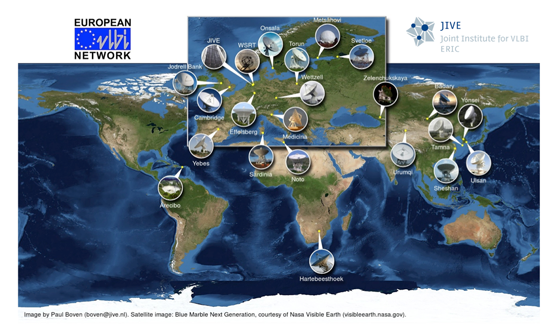EVN Call for Proposals - 1st June 2016 Deadline
- Contemporary messages sorted: [ by date ] [ by thread ] [ by subject ] [ by author ] [ by messages with attachments ]
From: Michael Lindqvist <michael.lindqvist_at_email.protected>
Date: Wed, 4 May 2016 13:31:40 +0000
European VLBI Network
Call for Proposals
Deadline 1st June 2016
[cid:6D484CCC-E724-43B5-A20F-E325D5297A54]
Introduction
The European VLBI (Very Long Baseline Interferometry) Network (EVN, http://www.evlbi.org/) is a network of radio telescopes in Europe, Asia, South Africa and North America, which allows imaging at radio wavelengths with millarcsecond resolution (from 0.001'' to 0.1'') using the VLBI technique. Wavelengths covered are from 0.7 cm (43 GHz) to 90 cm (345 MHz).
The EVN facility is open to all astronomers. Use of the Network by astronomers not specialised in the VLBI technique is encouraged. Advice on the feasibility of possible projects or help with preparing proposals is available from the Joint Institute for VLBI ERIC (JIVE) in the Netherlands (http://www.jive.eu/evn-user-support-jive).
The next proposal deadline is June 1st 2016. Further details and web links to the EVN are available via the detailed call for proposals at: http://www.oso.chalmers.se/evn/call.txt
VLBI science
VLBI continuum observations generally observe high brightness temperature radio emission from synchrotron or gyro-synchrotron processes with thermal emission perhaps detectable on short baselines. Radio spectral lines are observable in maser emission (mainly OH, H2O, CH3OH, and SiO) and in absorption against bright continuum sources (mainly in HI and OH).
VLBI observations with full-Stokes correlation allow investigation of polarization structure within your continuum or spectral-line targets. This in turn would allow detection and estimation of magnetic fields and ionised gas densities via Zeeman splitting, Faraday rotation, and Faraday depolarisation mechanisms.
VLBI has the extreme angular resolution to follow changes in source structure on timescales of hours (for stars), months (for many Galactic objects), and years (for many high-redshift systems).
Absolute and relative astrometry of compact radio structure is possible at the (sub)milliarsecond level, which for Galactic objects may allow the measurement of both parallax and proper motion to be made.
Additional information
* A selection of recent highlights is presented here: http://www.jive.eu/jivewiki/doku.php?id=evn:evn_science
* A selection of refereed EVN publications during 2016 is presented here: http://www.jive.eu/jivewiki/doku.php?id=evn:evn_publications
* Further information on EVN observations, and guidelines for proposal submission are available at:
http://www.jive.eu/jivewiki/doku.php?id=evn:guidelines
* The EVN User Guide (http://www.evlbi.org/user_guide/user_guide.html) describes the network and provides general information on its capabilities.
Apologies if you have already received this message and for any cross-posting.
Best regards,
Michael Lindqvist
EVN PC Chair
---------------------------------------------------------------------------------------------
Michael Lindqvist
Onsala Space Observatory
S-439 92 Onsala
Sweden
Phone: +46-31-7725508
Fax: +46-31-7725590
E-mail: Michael.Lindqvist_at_email.protected>
WWW: http://www.chalmers.se/rss
---------------------------------------------------------------------------------------------
Received on 2016-05-04 23:32:17
Date: Wed, 4 May 2016 13:31:40 +0000
European VLBI Network
Call for Proposals
Deadline 1st June 2016
[cid:6D484CCC-E724-43B5-A20F-E325D5297A54]
Introduction
The European VLBI (Very Long Baseline Interferometry) Network (EVN, http://www.evlbi.org/) is a network of radio telescopes in Europe, Asia, South Africa and North America, which allows imaging at radio wavelengths with millarcsecond resolution (from 0.001'' to 0.1'') using the VLBI technique. Wavelengths covered are from 0.7 cm (43 GHz) to 90 cm (345 MHz).
The EVN facility is open to all astronomers. Use of the Network by astronomers not specialised in the VLBI technique is encouraged. Advice on the feasibility of possible projects or help with preparing proposals is available from the Joint Institute for VLBI ERIC (JIVE) in the Netherlands (http://www.jive.eu/evn-user-support-jive).
The next proposal deadline is June 1st 2016. Further details and web links to the EVN are available via the detailed call for proposals at: http://www.oso.chalmers.se/evn/call.txt
VLBI science
VLBI continuum observations generally observe high brightness temperature radio emission from synchrotron or gyro-synchrotron processes with thermal emission perhaps detectable on short baselines. Radio spectral lines are observable in maser emission (mainly OH, H2O, CH3OH, and SiO) and in absorption against bright continuum sources (mainly in HI and OH).
VLBI observations with full-Stokes correlation allow investigation of polarization structure within your continuum or spectral-line targets. This in turn would allow detection and estimation of magnetic fields and ionised gas densities via Zeeman splitting, Faraday rotation, and Faraday depolarisation mechanisms.
VLBI has the extreme angular resolution to follow changes in source structure on timescales of hours (for stars), months (for many Galactic objects), and years (for many high-redshift systems).
Absolute and relative astrometry of compact radio structure is possible at the (sub)milliarsecond level, which for Galactic objects may allow the measurement of both parallax and proper motion to be made.
Additional information
* A selection of recent highlights is presented here: http://www.jive.eu/jivewiki/doku.php?id=evn:evn_science
* A selection of refereed EVN publications during 2016 is presented here: http://www.jive.eu/jivewiki/doku.php?id=evn:evn_publications
* Further information on EVN observations, and guidelines for proposal submission are available at:
http://www.jive.eu/jivewiki/doku.php?id=evn:guidelines
* The EVN User Guide (http://www.evlbi.org/user_guide/user_guide.html) describes the network and provides general information on its capabilities.
Apologies if you have already received this message and for any cross-posting.
Best regards,
Michael Lindqvist
EVN PC Chair
---------------------------------------------------------------------------------------------
Michael Lindqvist
Onsala Space Observatory
S-439 92 Onsala
Sweden
Phone: +46-31-7725508
Fax: +46-31-7725590
E-mail: Michael.Lindqvist_at_email.protected>
WWW: http://www.chalmers.se/rss
---------------------------------------------------------------------------------------------

(image/png attachment: 6D484CCC-E724-43B5-A20F-E325D5297A54.png)
